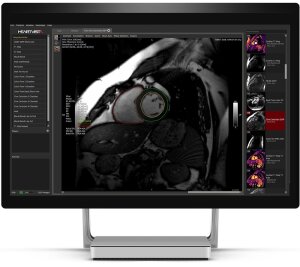by
John R. Fischer, Senior Reporter | January 26, 2023

Vista.ai's One Click MRI software
In a clinical study evaluating Vista.ai’s One Click MRI software for cardiac imaging, full AI-assisted scanning times were threefold more consistent than those of unassisted scans, and produced in 64 minutes at most, compared to 161 minutes.
This, along with other benefits, contributed to higher adoption rates for the technology among hospital imaging staff, according to Dr. Raymond Kwong, director of cardiac magnetic resonance imaging for Harvard-affiliated Brigham and Women’s Health, who evaluated the technology’s use in approximately 1,100 consecutive studies on cardiomyopathy and structural heart disease.
One Click MR is an AI-driven, one-click MR solution that produces high-quality heart images, while automating the entire exam with one click, creating a simpler, streamlined workflow and improving image consistency to allow the RM technologist to complete the cardiac scan in a regular mixed-use MR time slot.



Ad Statistics
Times Displayed: 46608
Times Visited: 1410 MIT labs, experts in Multi-Vendor component level repair of: MRI Coils, RF amplifiers, Gradient Amplifiers Contrast Media Injectors. System repairs, sub-assembly repairs, component level repairs, refurbish/calibrate. info@mitlabsusa.com/+1 (305) 470-8013
Despite being considered the gold-standard heart imaging diagnostic exam, cardiac MR is notoriously difficult and time-consuming, and requires specially-trained CMR technologists, for which there is only one out of every 20 MR machines in the U.S.
And while demand for the exam has risen, obstacles in the path of adoption and utilization of this technology have led to only 2% of MR scans today being used for cardiac-related illnesses, even though 7% of American adults are diagnosed with cardiovascular disease.
"The pandemic further increased the demand for CMR due to the increased incidence of COVID-19-induced myocarditis and pericarditis, which the CDC has estimated at nearly 16 times the normal risk. CMR is the best available noninvasive test to diagnose these two conditions," Vista.ai CEO Itamar Kandel told HCB News.
Prior to the One Click MRI study, some outpatients were waiting up to three to four weeks for a CMR scan, with even the sickest patients often not able to receive one for two to five days, said Kwong.
Kwong compared traditional CMR exams to both partial and full AI-assisted scans between April and September 2022. Full AI-assisted scans were 31% shorter than non-AI ones, and 90% of full AI-assisted scans were completed in 45 minutes, compared to only 25% in the same time frame.
Additionally, voluntary use of One Click MRI grew as technologists saw how simple it was to use and the benefits it offered firsthand, said Kwong. From the first full month that One Click MRI was available (May) to the end of the study (September), the rate of adoption by technologists grew from 13% to 55%.
“We believe that with continued use of One Click MRI, we will further reduce scan times to an average of 30 minutes, shrink the backlog to improve upon pre-pandemic levels, and sustain a CMR growth rate of about 15% a year," said Kwong.
Vista.ai recently said it would be expanding the technology’s use beyond the heart to other anatomies, including the prostate and musculoskeletal areas like the spine. Academic medical centers have already initiated clinical studies to evaluate its use with these anatomies.
"Our clinical collaborators, research partners and customers will continue to conduct studies to ensure we have unbiased, uncontroversial data on One Click MRI to quantify its benefit and further improve the software," said Kandel.
Kwong will discuss the study at a breakfast symposium on January 27 at the SCMR Scientific Sessions in San Diego.
The findings were published in
SCMR Scientific Sessions.

